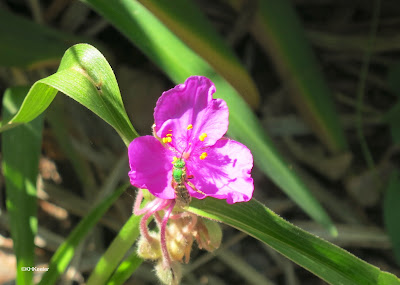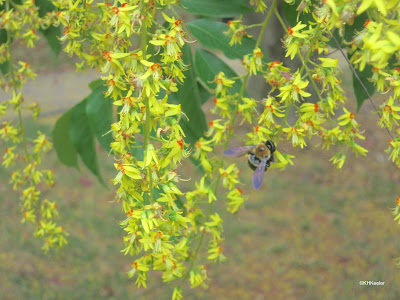Bees are numerous and are good pollinators, so many plant species have flowers tailored to bees.
 |
| Bumblebee (Bombus) pollinating golden banner (Thermopsis montana) |
For plants, pollination is about reproduction: the pollinator must carry pollen (containing the sperm) to the stigma, where it will grow down the style to the ovary (containing the egg). Outcrossing, reproduction between different genetic individuals, is better than self-pollination because the progeny are more diverse, better able to live in a complex world. Thus, good pollinators do not wander around having gotten pollen on them but go to another flower of the same species, ideally on a different plant. Bees do that well. A single worker often focuses on a particular plant species and spends the morning going from flower to flower gathering nectar and spreading pollen, ignoring other plants nearby that may be available.
Bees are quite diverse though, some larger than your thumb, some less than 1/4 inch in length. Some live in colonies of thousands of workers, some are solitary. Thus, flowers adapted to bees can be, and are, very diverse.
 |
| A sweat bee (halictid) pollinating spiderwort (Tradescantia) |
To be pollinated, the pollinator has to find the flower. Bees are mainly active by day and most orient visually not by smell or sound, so to attract bees, the flowers should be bright-colored. Not just bright-colored but easily seen against a background of leaves and stems. Few bee flowers are green, brown, or black. Secondly, the vision of common bees like honey bees (Apis melifera) and bumblebees (Bombus species) is different from the vision of humans. Bees do not see red, it is the same as black to them, but can see wavelengths at the other end of the visual spectrum that humans cannot. Ultraviolet, the wavelengths beyond violet where humans see black, is a color to bees. Bee-adapted flowers are yellow, blue and purple, some orange, white, not true red. They often have ultraviolet markings which humans can only detect using ultraviolet photography. That said, flower color is complex, both in its chemistry and its evolution. Bees are resourceful foragers, you will find them visiting flowers in colors that this overview suggests they would not.
 |
| honeybee (Apis melifera) pollinating blue bachelor button (Centaurea cyanus) |
Below, a tropical spurge (Euphorbiaceae) which has yellow to attract bees and red for other pollinators. And lots of nectar (the shiny "eyes").
 |
| Red bracts around yellow recepticle; bees found it despite all that red |
The bigger the display, the farther away it is visible. One solution is large flowers, think of amaryllis (Amaryllis). But the plant can make a big display by having several or many flowers together, all close together on their stems, like the stonecrop (Sedum) shown below or even more tightly packed as is common in the very large family Asteraceae, where lots of tiny flowers form the big head.
 |
| Amaryllis; one very big, very showy flower |
Bees are foraging for food, so the bright floral display that humans like so well is just the advertising. When they get to the flower, for the bee forager to visit a number of flowers after the first one, there has to be a reward. Bees gather pollen which is highly nutritious to feed to their larvae in the nest. Adult bees get their own energy from nectar, sugar water often with added amino acids. Most plants have pollen to gather, though some provide more than others, and most bee-pollinated plants offer nectar. Since the bee does not care if the plant is pollinated, the flower's structure forces the right-sized bee to contact both the anthers containing pollen and the stigma that leads to the ovary.
 |
| rubber rabbitbrush (Ericameria nauseosa) makes a dramatic display with lots of small flowers. It has quite good nectar in each small flower. |
Bees are happy to land and walk across a flat flower, but if the reward is good, they will hang off a dangling flower or pull open a closed flower to feed on the nectar within. Plants take different approaches to the pollinators they attract. Open flowers are generally available to be pollinated by a wide variety of insects, not just bees but flies, butterflies and beetles. Lots of flower visitors, some of them good pollinators. In contrast, plants with closed flowers like bottle gentians (Gentiana) are not visited by any insects except bees because the nectar is concealed within the petals. Only a bee is strong enough and smart enough to pull apart the petals to get to the nectar. And gentians provide a very rich nectar, making it worth the effort. (see video with flowers; watch bumblebee go in ) Generalist flowers can count on some pollination but lots of pollen is wasted on insects that don't visit another flower and pollination may be mostly within the same plant. Gentians and others with complex flowers get much better pollination--the bee goes from one gentian to another, searching carefully for this good reward--but can seriously lack pollination if something happens to the usual bees.
 |
| bumblebee visits hanging flower of harebell, Campanula |
What makes pollination so marvelous is the variety. Bees of many sizes and colors; flowers of even more shapes, sizes and colors. Notice flowers as advertising and which ones draw bees.




No comments:
Post a Comment